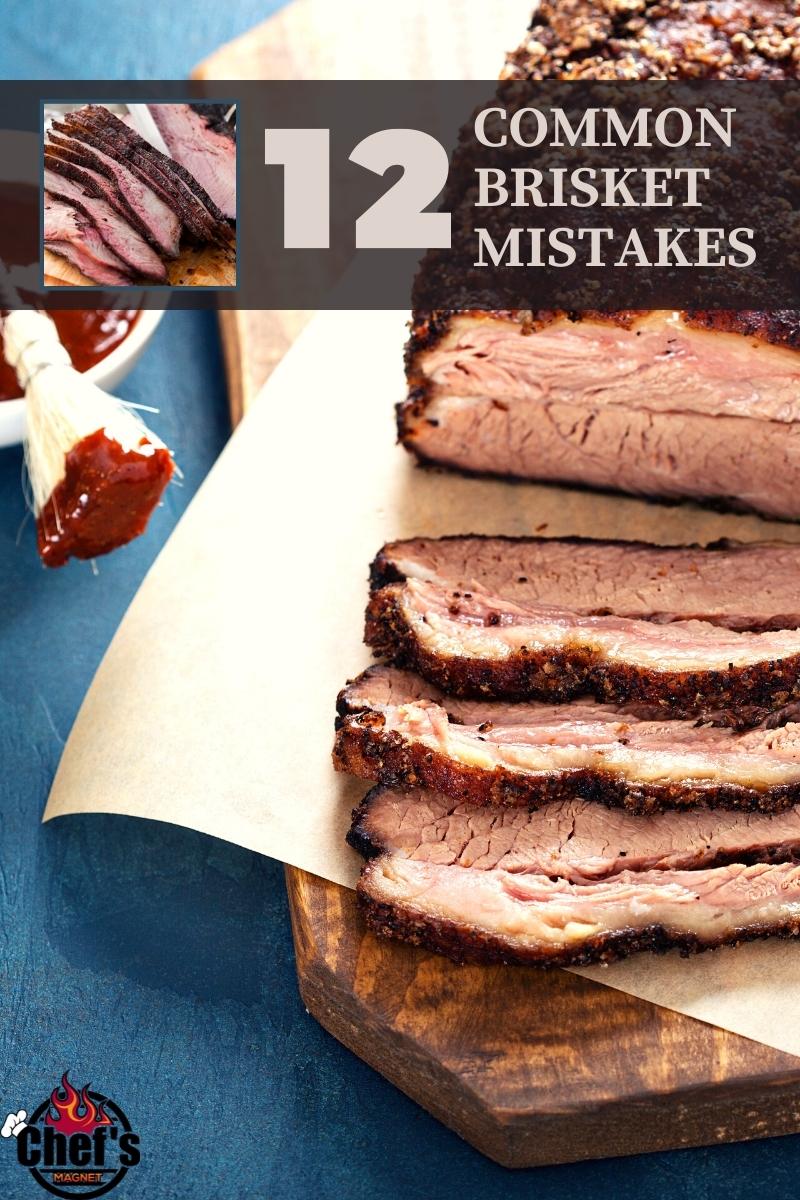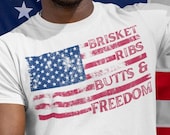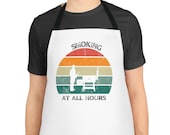Here are the 12 most common brisket mistakes that I’ve come across while smoking my briskets, along with researching what others have learned—a big shout out to Jeremy, the Mad Scientist BBQ, for his help in creating this list.

Brisket Mistake #1 Not Smoking at the Correct Temperature
People are cooking at too high a temperature on their pellet grill. They see people like Aaron Franklin using his very expensive smoker with fantastic constant airflow. If you try smoking at 275°F on your pellet smoker, you’ll end up burning your meat.
While Franklin and others smoke at 275°F in their more expensive smokers, you should set your pellet grill at 225°F because you don’t get the constant airflow as Aaron Franklin does.
Since different smokers’ styles operate differently, you’ll need to adjust your smoking temperature to match your smoking apparatus choice.
Here are my recommendations for different types of smokers:
- Pellet Grill 225°F
- Small off-set smoker 250°F
- Big off-set smoker 275°F
- Ceramic cooker like a Big Green Egg 225°F
- Weber Smokey Mountain or Weber Kettle 225-250°F

Brisket Mistake #2 Using the Wrong Rub
There are two extremes people go to when seasoning their brisket. On one end, some people use a rub with tons of flavors and even combine more than one rub. Then some people go for ultimate simplicity and only use salt and pepper. Which should you use? What’s the correct answer?
It depends on the kind of smoker you’re using. Salt and pepper are a great way to go if you’re using a large offsetsince your meat will get a ton of smoke flavor. However, if you’re using a pellet grill, you won’t get as much smoke flavor. You’ll still get great taste, but it won’t be as strong as a large or small offset smoker.
When using a pellet grill to smoke brisket, it’s a good idea to use rub blends instead of going simple and only using salt and pepper. Remember that you don’t want to go overboard and use too much rub. Those fine particles covering the brisket’s entire surface will make it difficult for the smoke to penetrate. This will cause you to have a less smoky flavor.
If you are smoking on an Offset Smoker, you will get a lot of smoke, adding much flavor, so you can get away with just using salt and pepper as a rub.

Brisket Mistake #3 Not Allowing Yourself Enough Time Before You Have to Serve Your Food
A widespread and colossal mistake is not adequately planning when your brisket will be ready to serve.
Let’s say you plan out that it will take 10 hours to smoke, an hour to rest, and when your guests are ready to eat, 30 minutes after that. Inevitably things will go wrong. Many variables come into play when cooking outside, which can throw off your smoking time, causing your brisket to take longer to cook.
A few of these include the stall taking a lot longer or even going much faster than predicted, is it cold and windy. Hence, your smoker has a more challenging time maintaining temperature, or is there high or low humidity in the smoker that day. There are many variables you can’t control.
Always plan out an additional two and a half hours when smoking a brisket. Doing this will help ensure you’re serving delicious meat on time. With a brisket, you can always let it rest for hours in a cooler, and you’ll be just fine.

Brisket Mistake #4 Not Letting Your Brisket Rest Long Enough
Beyond the wood you use or the rub you apply, an essential step that you should be doing is resting your brisket correctly. Resting is a critical step that allows the rendered fats to redistribute evenly.
Your smoke time can vary if you’re using a small cooker for brisket versus a larger one. The size, along with the many uncontrollable variables that come from cooking outside, you can’t plan exactly how long it will rake.
Here’s how to plan out smoking and to rest a brisket:
Smoked 8 hours or less – After removing the brisket, place it in a cooker and allow it to come down to serving temp slowly.
Smoked 8 – 12 hours – Pull the brisket out of the smoker and allow it to come down to about 180°F, then allow it to rest in a cooler.
Smoked 12+ hours – After removing the brisket from the cooler, allow it to come down to about 165-170°F, place it in the cooler to come down to serving temp slowly.
The ideal serving temperature for your brisket is 145°F. Ideally, you want to rest your meat until it reaches this temperature before slicing and serving. However, depending on starting the meal, you may need to slice it sooner. Just don’t allow the brisket to go below 135°F for a while.

Brisket Mistake #5 Making Changes That Are Too Big
It is good to make changes and experiment when smoking a brisket. Minor changes are how you discover what you like most while gaining experience. However, unless the last time you smoked brisket was a complete disaster, don’t change everything you’re doing this time from last time.
You’ll notice if that change made a difference for good or bad from your final result by making small changes. If you make multiple changes, you won’t know what caused it not to turn out. Don’t change the wood, smoking temperature, injection, rub, and more all at once. By making small changes over time and through several trials, you’ll work your way towards the brisket you crave the most.
There are many variables you don’t have control over. Some of these include the temperature outside, the humidity, the moisture in the wood, etc. Stick to making small changes from what you can control to learn each time you cook.

Brisket Mistake #6 Looking for the Wrong Signs in Your Brisket
Many people focus on time and internal temperature when smoking a brisket. Time isn’t a factor you’ll consider when determining if your meat is ready, and internal temp is only one part of the overall indicators you’ll need to track.
There are five things to look for before you wrap your brisket.
Number 1 – Color
Color is your indicator to know how much smoke flavor you’ve put on your brisket. Generally speaking, the darker the brisket, the more smoke has penetrated the meat. The whole reason you put this in a smoker over an oven is to get the smoke flavor, so make sure you have a nice dark, smoky look to the meat.
Number 2 – Bark
You want to have a build-up of stuff on the surface of your brisket. The bark that forms will be a combination of your rub, the fat render, and the meat itself, all turning into this delicious covering on your brisket. Don’t wrap before you have this nice bark on the outside.
Number 3 – Evaporation
You want your brisket to let out a lot of water during the smoking process. When you lose water, your brisket will shrink down in size. If you see it shrink by about 40%, that’s a sign it might be time to wrap.
If you don’t let the water evaporate from the meat before you wrap, it will fill the wrap with moisture and create a “soupy” liquid that will wash off the barkyou worked so hard to create.
If you make sure your brisket loses enough water before wrapping, the flavor will be more concentrated, and a better bark will remain.
Number 4 – Fat Render
Look at the fat on top of the brisket to be rendered. The fat should turn yellow and not have any resistance when poked. When poking, the fat shouldn’t bounce back like rubber when you push it with your finger. It should feel soft. That’s rendered fat.
Number 5 – Temperature
Temperature isn’t the only metric that you should use. I use this as my last step, where it makes a good gauge to know that I’m not way off base with my other measurements.
Check both the point and flat temperatures to be around 165-175°F to know if it is ready. If you’re not confident at using the other four steps, using the temperature is a great best guess that you’re ready to wrap.

Brisket Mistake #7 Don’t Spray the Fat
When you spray your brisket, don’t wet the fat. You want the fat to get hot and render, and moisture will cool it off. You’re spraying the meat to protect it, and the fat doesn’t need saving. If you get some fat wet, don’t concern yourself too much.

Brisket Mistake #8 Over Smoking or Under Smoking
You don’t want to over-smoke your meat, causing a more bitter flavor. You will most likely not over-smoke the brisket using a large or small offset smoker. An excellent gauge uses the look of the meat to know how much smoke has penetrated the surface.
You can also use a smoking tube to add more smoke to your cook on a pellet grill since a pellet grill doesn’t create as much smoke as an offset.

Brisket Mistake #9 Wild Temperature Swings
If you’re using a pellet grill, you can skip this tip. Your smoker works well, maintaining the temp inside the grill.
With an offset smoker, you’ll need to keep a close eye on the temperature. If you walk away for an hour and the fire goes down, not only did you lose that hour, but your brisket began to cool.

Brisket Mistake #10 Using Low-Quality Meat
As with many things in life, you get what you pay for when you buy meat. Outside of Waygu beef, which’s expensive, which you don’t need to purchase to make great brisket, there are three grades to choose from. Don’t pick select! You’ll be setting yourself up for failure if you do. It is tough to make a great brisket from a Select grade. You need to know what you’re doing to salvage that cheaper meat.
Go with at least Choice but do what you can afford. Most people have access to a Costco, which typically sells Prime brisket for a fair price. You can find one for around $60 for a prime brisket, which will help you make a fantastic final product. By choosing Choice or Prime, you’re setting yourself up for success.

Brisket Mistake #11 Wrapping Improperly
Whatever you use to wrap your brisket, make sure you do it well.
If you’re using foil, make sure it is nice and tight so steam isn’t escaping. Since you’re choosing foil, you don’t want to lose any of that steam, so make sure to use the foil properly.
Many people will wrap it loosely when using paper, but this causes leaking and doesn’t work well. Make sure to wrap it tightly and well.
Make sure you wrap tightly, so you’ll achieve the purpose of why you’re covering in the first place.

Brisket Mistake #12 Improperly Trimming Your Brisket
If you trim off too much fat, you’ll be left with a dry brisket, especially if you’re smoking. Also, you don’t want to leave too much fat behind. Don’t be afraid to trim the fat, and then save it to use in your burger meat or some other option.
Rule of thumb, be ruthless when trimming the brisket. Cut it off if you have a small thin piece jetting out from the end. By doing this, you’ll have a better product when finished.
If you want to learn more, click over here to learn how to smoke a brisket.
Below is a Pinterest friendly photo…. so you can pin it to your Smoking Food Board!!



![Personalized Science T-Shirt, [NAME] Eats Bacon Periodically, Science Gift For Teachers, Gift For Dad](https://i.etsystatic.com/39088648/c/677/537/250/479/il/81da41/5524136388/il_170x135.5524136388_ejht.jpg)
![Personalized Funny BBQ Gift T-Shirt, [NAME] Likes To Smoke Food It Gives Him A Reason To Play With Fire, Gift For Men, Gift For Dad](https://i.etsystatic.com/39088648/c/715/567/310/398/il/df3b57/5524134348/il_170x135.5524134348_l4vh.jpg)
![Personalized Funny BBQ Gift T-Shirt, [NAME]'s Addicted To Smoking, Gift For Men, Gift For Dad](https://i.etsystatic.com/39088648/c/688/546/321/419/il/04f17e/5572258249/il_170x135.5572258249_loz4.jpg)
![Personalized Option Funny BBQ Gift T-Shirt, Don't Worry I Got This I Watched A YouTube Video, Quite by [NAME] Gift For Men, Gift For Dad](https://i.etsystatic.com/39088648/c/1451/1152/714/207/il/eecec9/5524515802/il_170x135.5524515802_qbvj.jpg)


![Personalized Funny BBQ Gift Mug, Don't Worry I Got This I Watched A YouTube Video, By [NAME], Gift For Men, Gift For Dad](https://i.etsystatic.com/39088648/c/2982/2368/0/27/il/cf62b0/5272771721/il_170x135.5272771721_pz0h.jpg)

![Personalized Science Apron, [NAME] Uses [Pronoun] Smoker Periodically, Science Gift For Teachers, Gift For Dad](https://i.etsystatic.com/39088648/c/2982/2368/0/9/il/6bf723/5272542103/il_170x135.5272542103_18nf.jpg)

